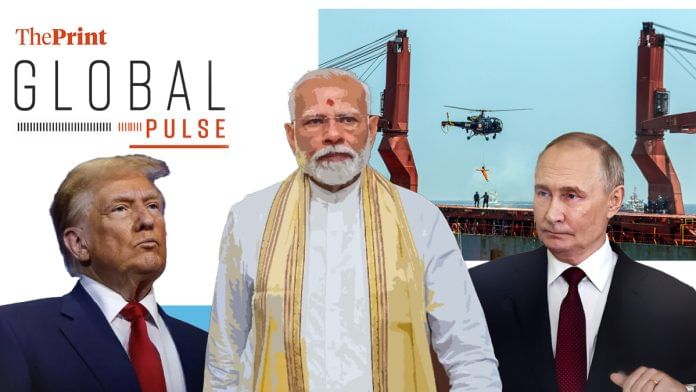New Delhi: International media outlets spotlight United States President Donald Trump’s bold declaration that India will no longer buy Russian oil, followed by India’s seemingly evasive response.
In The New York Times, Mujib Mashal and Pragati K.B. report that the Indian government appeared to “push back against Trump’s claims”, not “explicitly rejecting” Trump’s statements but maintaining that India seeks diverse sources when it comes to energy imports.
“The non-confrontational response is a sign of how Mr Modi is seeking to find a delicate resolution with the Trump administration to lift hefty US tariffs, in the hopes of restoring calm to a relationship with Washington that was carefully nurtured over two decades,” the report says.
However, the report notes a change in tack. A few months ago, when Trump made a similar round of claims, MEA spokesperson Randhir Jaiswal “walked a more careful line”. “Earlier, he had issued a statement that amounted to a denial, without challenging the president directly,” says the report.
“If Trump wants India to behave a certain way, going public about it is the worst thing he could do,” Harsh V. Pant, a visiting professor of international relations at King’s College London, has been quoted as saying by the NYT. “It makes it difficult for a policymaker in a country like India to be seen to be toeing a particular line under American pressure.”
The Washington Post’s South Asia bureau chief Pranshu Verma writes that the contrary statements and the “confusion” serve as another example of “a relationship beset by mutual misunderstanding”.
“On Wednesday, Trump reiterated that the US was ‘not happy’ with Modi for buying oil from Moscow, which he said ‘lets Russia continue on with this ridiculous war’. Modi’s alleged pledge was a ‘big stop’, Trump said, adding that he now had to get China—Russia’s largest oil customer—’to do the same thing’,” the report says.
“India “is not too weak” and “not too powerful,” Happymon Jacob, founder of the Council for Strategic and Defense Research, a nonpartisan think tank in New Delhi, tells The Post. It’s “behaving like a typical middle power”, trying not to bow down and not bend the knee in front of Trump and not going overboard, too.
The editorial board of The Post writes that Trump’s punitive imposition of 50 percent tariffs on India does not work in favour of the US. In fact, it detracts from a greater American ambition to weaken China.
“It is in America’s national interest, then, for South Asia, and especially India, to grow at a rapid clip. That would create a counterweight in Asia to China’s massive economic and military expansion. Trump’s barrage of tariffs on India in August was supposedly a response to its importation of Russian oil, even though China is a bigger customer of the same product,” reads the editorial.
“But Trump is determined to negotiate a grand trade bargain with Chinese leader Xi Jinping, so he didn’t impose secondary sanctions on their purchases of Russian crude,” according to the editorial.
The BBC’s Soutik Biswas asks a critical question: Can India really do without Russian oil?
“Last year, India, the world’s third-largest oil importer, bought $52.7bn of Russian crude—37 percent of its oil bill— followed by Iraq, Saudi Arabia, the UAE, Nigeria, and the US,” the report says. “Before the Russian imports surged, India’s top 10 crude suppliers in 2021-22 were Russia, Iraq, Saudi Arabia, the UAE, the US, Brazil, Kuwait, Mexico, Nigeria, and Oman. The remaining 31 countries formed a long tail of smaller, opportunistic deals that ebb and flow with global prices.”
The Ukraine war became the clincher, cementing India’s position today.
“The second transition came with the Ukraine war,” writes Biswas. India’s imports of Russian oil soared— four million tonnes in 2021-22 to over 87 million tonnes in 2024-25. The surge was driven by discounts offered by Russia after Western sanctions, making its crude more attractive to Indian refiners.
The Economist carries a report card on India’s bankruptcy code, which was supposed to mark an end to a “defaulter’s paradise” in its Essential India newsletter. The results are “mixed”.
“Of 8,000 firms that were admitted into the insolvency programme, over three-fifths were successfully dealt with. But three out of four cases exceed the deadline. Of the 1,900 ongoing cases, 78 percent are overdue beyond 270 days—up from 68% in June last year—according to CareEdge Ratings, a research outfit. Recoveries, at 32 percent, are only marginally better,” reads the newsletter, going on to highlight overarching issues such as judicial delay and a lack of adequate infrastructure.
(Edited by Madhurita Goswami)
Also Read: China is the only nation gaining from Russia-Ukraine war. India must rethink multi-alignment






